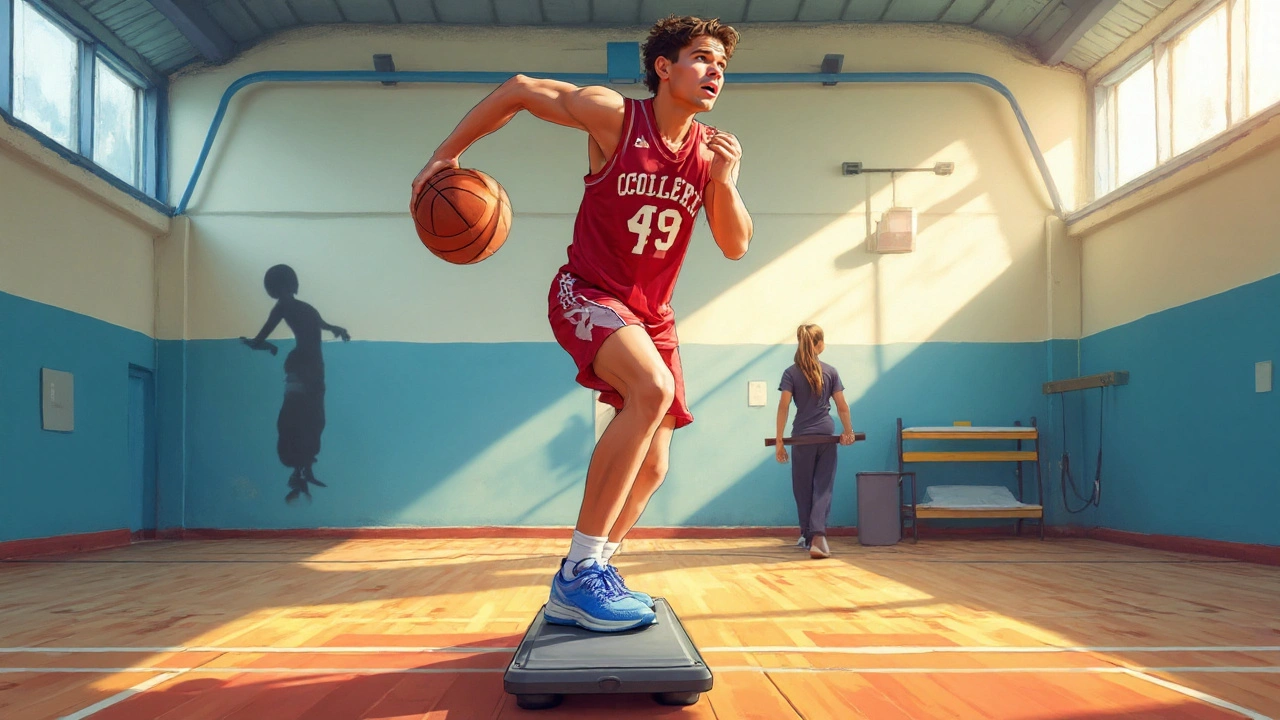High ankle sprain is a type of ankle injury that damages the syndesmosis, the ligamentous bridge linking the tibia and fibula above the ankle joint. Unlike the more common lateral ankle sprain, this injury destabilizes the whole ankle mortise and often requires a different rehab approach.
Most athletes and active folks assume every ankle twist is the same, but the mechanics, healing timeline, and treatment protocols for a high ankle sprain are uniquely demanding. This guide walks you through the anatomy, symptoms, imaging, and step‑by‑step rehab plan so you can get back on your feet with confidence.
Understanding the Anatomy: Tibia, Fibula, and the Syndesmosis
Syndesmosis is the fibrous joint formed by the interosseous membrane and the tibiofibular ligaments that bind the tibia and fibula together. Its primary role is to maintain the proper spacing of these two bones during weight‑bearing activities.
The tibia (shinbone) and fibula (the slender bone on the outside of the lower leg) act like the rails of a railway; the syndesmosis is the track that keeps them aligned.
Key ligaments include the Anterior Inferior Tibiofibular Ligament (AITFL), which resists forward displacement of the fibula, and the Posterior Inferior Tibiofibular Ligament (PITFL), which stabilizes backward movement. Damage to any of these structures creates a high ankle sprain.
How a High Ankle Sprain Differs from a Lateral (Typical) Ankle Sprain
| Feature | High Ankle Sprain | Lateral Ankle Sprain |
|---|---|---|
| Primary Structures Injured | Syndesmosis (AITFL, PITFL, interosseous membrane) | Anterior talofibular ligament, calcaneofibular ligament |
| Typical Mechanism | External rotation of foot with a planted leg | Inversion (foot rolls inward) |
| Visible Swelling | Above the ankle, less obvious | Below the ankle, obvious bruising |
| Healing Time | 6-12 weeks (sometimes longer) | 2-6 weeks |
| Return‑to‑Sport Criteria | Full weight‑bearing without pain, proven stability on stress test | Full range of motion and strength |
Notice how the injury site sits higher on the ankle and why the rehab timeline stretches out. These differences dictate everything from imaging choices to the type of brace you’ll wear.
Common Causes and Risk Factors
- Contact sports (football, rugby) where players land on a fixed foot.
- Field sports (soccer, lacrosse) involving sudden cutting or pivoting.
- Falls from height that force the foot into external rotation.
- Previous ankle instability that predisposes the syndesmosis to overload.
Even everyday activities like slipping on wet pavement can trigger a high ankle sprain if the foot is locked in place and the leg twists.
Signs, Symptoms, and When to Seek Care
Typical complaints include:
- Dull ache or deep pressure pain above the ankle, especially when walking.
- Difficulty walking on uneven surfaces.
- Swelling that peaks 48‑72hours post‑injury, often higher than a regular sprain.
- Feeling of “looseness” when the foot is rotated outward.
If pain persists beyond 48hours, or you notice a “gap” sensation when rotating the foot, see an orthopedic surgeon for a professional evaluation.
Imaging and Assessment Tools
Because external swelling can mask the injury, physicians rely on specific diagnostics:
- X‑ray - first‑line to rule out fractures and to assess the tibiofibular clear space.
- MRI - gold standard for visualizing ligament tears, interosseous membrane disruption, and associated cartilage damage.
- Stress radiographs - a controlled external rotation test that quantifies syndesmosis widening.
Studies from leading sports medicine journals (American Journal of Sports Medicine, 2023) show MRI sensitivity of 94% for detecting AITFL tears, making it the go‑to tool for serious athletes.

Unique Treatment Needs: From Initial Care to Functional Bracing
The classic RICE protocol (rest, ice, compression, elevation) still applies, but a high ankle sprain usually needs additional protection:
- Immobilization: A walking boot or short leg cast for 2-4weeks depending on tear severity.
- Functional brace: After the acute phase, a functional brace that limits external rotation while allowing controlled motion promotes early weight‑bearing.
- Medication: NSAIDs can reduce pain, but avoid prolonged use that may blunt early inflammation signaling.
- Early physiotherapy: A physical therapist specializing in sports injuries guides gentle range‑of‑motion drills on day3‑5 to prevent stiffness.
The goal is to protect the syndesmosis while preventing muscular atrophy and joint stiffness.
Rehabilitation Phases and Timelines
Rehab is usually broken into three progressive phases:
Phase1 - Protection & Gentle Motion (Weeks0‑2)
- Ankle pumps and toe curls to maintain circulation.
- Isometric strengthening of the peroneals and tibialis anterior.
- Weight‑bearing as tolerated in the boot.
Phase2 - Controlled Load & Stability (Weeks3‑6)
- Transition to the functional brace.
- Closed‑chain exercises: mini‑squats, single‑leg balance on foam.
- Proprioceptive drills: wobble board tilts, lateral hops.
Phase3 - Power & Return‑to‑Sport (Weeks7‑12+)
- Plyometric work: bounding, box jumps, sprint drills.
- Sport‑specific cutting patterns under supervision.
- Final clearance based on a stress radiograph showing no widening and a functional brace test with high ankle sprain stability.
Most athletes achieve full return by 10‑12weeks if they respect each phase’s criteria.
Return‑to‑Play Considerations
Before stepping back into competition, the following must be confirmed:
- Pain‑free full weight‑bearing for 48hours.
- ≥90% strength compared to the non‑injured side on a handheld dynamometer.
- Successful pivot and cut maneuvers without wobble on a force plate.
- Clear stress radiograph or ultrasound confirming ligament integrity.
Skipping any of these checkpoints dramatically raises re‑injury risk, especially in high‑impact sports.
Prevention: Strength, Mobility, and Proprioception
Even after complete healing, keeping the syndesmosis strong helps avoid future tears:
- Hip‑strengthening (glute bridges, clamshells) to control foot placement.
- Calf‑gastrocnemius stretches to maintain ankle dorsiflexion.
- Regular balance board sessions - 5 minutes daily can boost joint awareness.
- Warm‑up routines that include external rotation drills.
Related Concepts and Next Steps
Understanding a high ankle sprain opens the door to other ankle‑focused topics such as chronic ankle instability, post‑traumatic ankle arthritis, and advanced imaging techniques like weight‑bearing CT scans. Readers interested in exploring these areas should look for articles on "Ankle Arthritis After Ligament Injury" or "Weight‑Bearing CT for Complex Ankle Injuries."

Frequently Asked Questions
What is the main difference between a high ankle sprain and a regular ankle sprain?
A high ankle sprain injures the syndesmosis (the ligaments connecting the tibia and fibula), whereas a regular sprain usually affects the lateral ligaments on the outer ankle. This makes the high sprain more unstable and lengthens recovery.
How long does it take to heal a high ankle sprain?
Recovery typically spans 6-12 weeks, depending on severity and adherence to rehab phases. Elite athletes who follow a structured program can sometimes return in 8-10 weeks.
Can I walk with a high ankle sprain?
Yes, but only with protected weight‑bearing. A boot or functional brace is essential during the first few weeks to avoid further ligament stretch.
Is surgery ever required?
Surgery is reserved for complete ligament ruptures, diastasis >5mm on stress radiographs, or cases where conservative rehab fails after 3 months. An orthopedic surgeon may perform screw fixation or a suture‑button construct.
What exercises help prevent a high ankle sprain?
Focus on external rotation strength, hip stability, and proprioception. Exercises like resisted ankle external rotation, single‑leg deadlifts, and balance board circles are proven to reduce risk.
Will an MRI always show the injury?
MRI detects most ligament tears with >90% accuracy, but early micro‑tears might be missed. If clinical signs are strong, a stress X‑ray can still confirm syndesmosis widening.
How soon can I start running?
Typically after Phase2 (around week5‑6) once you can jog on a treadmill without pain and maintain balance on uneven surfaces. Gradual progression is key.
Are there any long‑term complications?
If not healed properly, chronic instability or early‑onset ankle arthritis can develop. Consistent rehab and proper footwear mitigate these risks.


Kate Taylor
September 25, 2025 AT 07:32Great breakdown of the syndesmosis anatomy-knowing the AITFL and PITFL is crucial for targeting rehab interventions.
When you’re in Phase 1, focus on isometric tibialis anterior work and ankle pumps to maintain circulation without overstressing the ligament.
Progress to controlled weight‑bearing in a boot once pain subsides, then transition to a functional brace to protect external rotation.
Remember, consistent proprioceptive drills during Phase 2 will shorten the timeline to safe return‑to‑sport.
Hannah Mae
October 10, 2025 AT 03:32i dont think high ankle sprains are that scary many athletes bounce back faster than u think.
maybe the guide overcomplicates stuff a bit.
Iván Cañas
October 24, 2025 AT 23:32The emphasis on early physiotherapy is spot on; getting range‑of‑motion drills in around day 3–5 prevents stiffness.
Also, incorporating peroneal strengthening early helps with the lateral stability that’s often overlooked.
Jen Basay
November 8, 2025 AT 19:32Sounds like the rehab plan really covers everything from ankle pumps to plyometrics 😊.
Keeping the boot on for the first couple of weeks while you start gentle isometric work sets a solid foundation.
Hannah M
November 23, 2025 AT 15:32I'm glad the guide highlights hip‑strengthening drills; a strong glute can really reduce that external rotation stress 🙌.
Stay patient with each phase and trust the stress‑radiograph results before pushing hard.
Poorni Joth
December 8, 2025 AT 11:32People who skip the immobilisation period are just asking for chronic instability and future arthritis you cant blame the body when you neglect proper care.
It is morally wrong to ignore the rehab protocol and think you are tough enough to skip the boot.